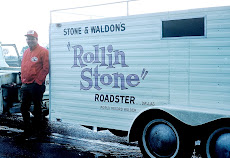The U S Navy has had five ships that carried the name Lexington, commemorating the Revolutionary War site...but this particular posting is about the ship built just in time for World War II. The keel was laid in 1941 and she slid down into the waters in early 1943 designated as CV-16. This ship was originally set to be named Cabot, but when it was discovered the previous Lexington had been sunk in the Battle of the Coral Sea, an immediate change was made so the lineage of Lexington's would continue for the U S Navy.
The above photo was taken in 1944 when the Lexington was part of the battle for the Philippine Sea. A Hellcat fighter is landing after taking part in what would be called 'the great Marianas Turkey Shoot.' The Japanese lost over 400 planes in this battle and their naval aviators would cease to be a factor.
This version of the Lexington was powered by four Westinghouse steam turbine engines, was 900 feet long, displaced over 48-thousand tons of water, carried a crew of 2,600 men and officers, and most importantly, carried 110 aircraft. The Lexington arrived at Pearl Harbor in August 1943 and immediately led the attacks on Tarawa, Wake Island, the Marshall Islands, and the Gilbert Islands. Late in December 1943 the Lexington took a torpedo in the battle for Kwajalein. Eleven sailors were killed and the Lexington limped home to Bremerton, Washington for full repairs.
Tokyo Rose would announce the sinking of the Lexington from this battle, but would have to eat her words when the Lexington showed up for the Battle of Leyte Gulf in the Philippines. Planes from the Lexington joined aircraft from the carrier USS Essex in sinking 7 ships (4 carriers) in two days to deal a death blow to the Japanese Navy. Known as the 'Blue Ghost' to the Japanese, the Lexington was thought to be sunk on four occasions only to show up later for more action. The Lexington was awarded eleven battle stars for her actions in World War II.
The U S S Lexington is now moored in the bay at Corpus Christi, Texas and that is where my wife and I visited her in 2006. Got to admit, Momma is the best looking anti-aircraft gunner the Lex ever had. The Lexington served longer than any other ship of the Essex class of ships, putting in fifty years before becoming a floating museum.
Corpus Christ was chosen because most of the naval aviators of World War II went through flight school there. The ship is a top attraction for visitors and is easy to find. Interstate highway 37 will take you to Corpus Christi and as soon as you cross over the bay, take the next exit. (It's sort of difficult to hide an aircraft carrier)
There are officials on hand to answer your questions and direct you to various spots on the ship, but the informal tour is basically up to you. Above my wife views a rolling exhibit of the Lexington while I am in the brig (they must have heard about me beforehand).
Some parts of the ship are roped off for visitors as it is in a constant state of repair and update. When other ships are being scraped, parts are brought to the Lexington to make it as authentic as possible.
The bridge or tower of the ship is a testament to her achievements in World War II. Ready to be launched on the 'A strip' is a F-14 Tomcat fighter. This was the most recent plane carried by the Lexington before being retired. The topside of the ship is a virtual museum of aircraft for visitors to inspect.
Planes and helicopters from the 1950's, 60's, and 70's were all on display. Being an infantry grunt during my time in the Army, I dislike any plane that does not have a propeller. The planes of the 1940's have always been my favorite,....EXCEPT the one behind me. That is a F4 Phantom, a twin-engine fighter/bomber built by MacDonald Douglas. My firebase in Vietnam was almost overrun by the Viet Cong until a squadron of Phantoms came to our rescue. I love the smell of napalm in the mornings....
I knew I would find propellers if I kept looking...Top photo is an Army Apache attack helicopter..and the yellow plane is a trainer aircraft from the 1950's, used at the Corpus Christi Naval Air Station.
There is a teakwood mock-up of a carrier deck used for training purposes at the U.S. Naval Academy at Annapolis, Maryland,...and the wood is from the deck of the U S S Lexington.
We bid farewell to the Lexington as Momma stands by the original bell of the Lexington.
There is a restaurant/souvenir shop across the street from where the Lexington is moored...and the entrance is through the sharks mouth. It was a fun trip and very entertaining. I highly recommend it if you are into visiting historical spots. Momma waves bye-bye.



















No comments:
Post a Comment